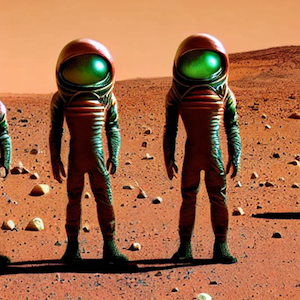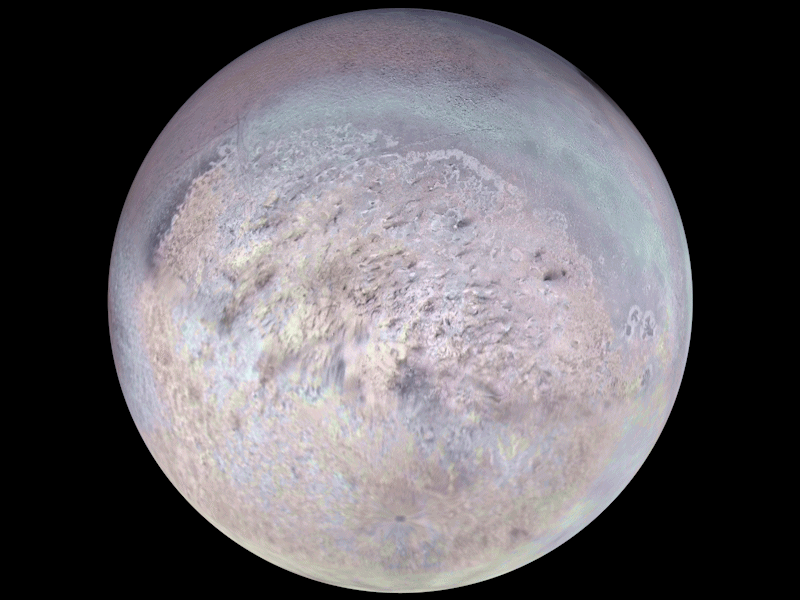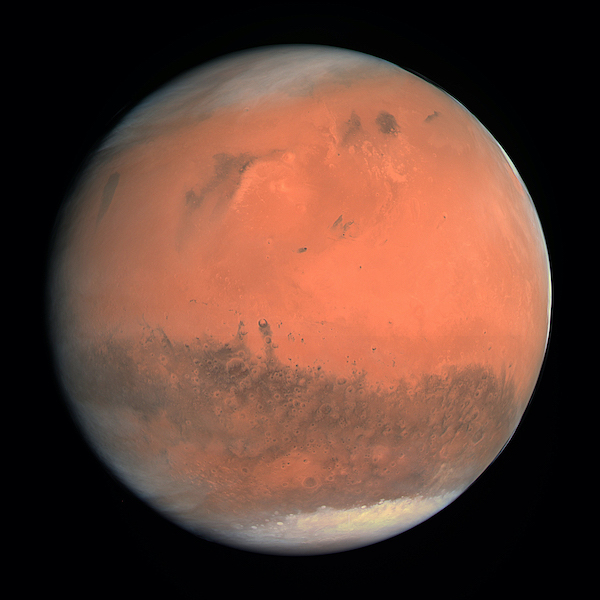Introduction
The question of whether or not we’re alone in the universe is a profound one. There is something terribly sad at the idea that our star is the only one that shines down on life. With a possible lower bound of $10^{22}$ stars in our universe and a universe almost 14 billion years old, that’s an average of almost two million stars created every day. While estimates of the number of planets vary, we think there are probably at least as many “Earth-like” planets as there are stars, that seems like two million chances per day of life being created. Of course, it’s much more than that because for every day that a planet doesn’t have life evolve, it has plenty of additional days, years, eons for life to evolve.
Given the preceding, many people are convinced that life is plentiful in the universe, but so far, we’ve never detected extraterrestrial life amongst the stars. Are we alone? Maybe. However, we should look closer to home. In fact, there are many intriguing clues in our own solar system which are worth examining. I’ll cover some of them, but I’ll save the best for last because it’s very exciting, even if we did overlook it for decades.
First, I want a to give a some background information for those who are curious about the search for extraterrestrial life but haven’t dug into the topic, just how complex it is. If that’s less interesting to you, you can skip ahead to the best candidates for life in our solar system.
Caveats
As with any writing on this topic, everything here is going to be a gross oversimplification. Unlike many other writings on this topic, I’m going to try to give a broad (but not deep) background into many of the issues involved. Sometimes I’ll provide additional caveats that might distract from the text, so you can click on the " " symbol for more context.
Life (as we know it)
First, when I write “life,” mentally add the words “as we know it” after that. I get tired of typing it. The definition of life is muddled, to put it kindly, and we only have one tree of life as a sample. We have no idea what alien lifeforms might be like.
Aliens?

Always remember that if the question is aliens, the answer is “no.” This might seem surprising to some who’ve attended my talks and heard me warn about those who use words like “always” and “never” in describing complex topics. People who use those words are often zealots. I don’t think I’m a zealot, but the default position of those who understand science is that extraordinary claims require extraordinary evidence. The existence of extraterrestrial life would be one of the most extraordinary claims of all time. So far, there’s no evidence of aliens. Thus, your default position should be “no aliens.”
Organic Compounds
You often hear the term “organic compounds” or “organic molecules” in connection with the search for life. Be careful.
In chemistry, organic compounds are just chemical compounds that contain carbon-hydrogen covalent bonds. In the popular press, we tend to use the term to mean any compound containing carbon, but it’s widely misinterpreted as “molecules related to life.” They are often related to life, but “organic,” in this context, does not mean life.
The Drake Equation
Before we can search for life, we have to define it. But before we get there, let’s think about the Drake Equation . This was created in the 1960s by the late Dr. Frank Drake as a thought experiment. Like “organic compounds,” this is also widely misunderstood. I’ve often seen it referred to as an equation that helps us understand the prevalence of life in the universe. In reality, it’s a tool to help us understand the possible number of currently communicating extraterrestrial civilizations that SETI might be able to detect. For the equation, the number $N$ is the number of civilizations we might be able to detect. The equation looks like this:
$$N = R_{*} ~ \times ~ f_{p} ~ \times ~ n_{e} ~ \times ~ f_{l} ~ \times ~ f_{i} ~ \times ~ f_{c} ~ \times ~ L$$
Those terms are:
- $R_∗$: the average rate of star formation in our galaxy
- $f_p$: the fraction of those stars that have planets
- $n_e$: the average number of planets that can potentially support life per star that has planets
- $f_l$: the fraction of planets that could support life that actually develop life at some point
- $f_i$: the fraction of planets with life that actually go on to develop intelligent life (civilizations)
- $f_c$: the fraction of civilizations that develop a technology that releases detectable signs of their existence into space
- $L$: the length of time for which such civilizations release detectable signals into space
Depending on how you fill in those numbers, we could be alone in the universe, or we could have many advanced extraterrestrial civilizations within our galaxy.
For our purposes, we’re most interested in $f_l$: how often does life evolve? In fact, we’re not even interested in just planets because life could possibly evolve on a moon (there are several interesting candidates). Some panspermia advocates even claim that life could have evolved in space, though this isn’t taken seriously by most scientists.
To be more specific, we’re asking “what are the odds of life spontaneously originating from simple organic compounds?” This is known as abiogenesis and is the subject of much research. The current consensus on an answer is, “we have no fucking idea.” What’s particularly maddening about this is that we’re not likely to have a clue until we detect other life. If we don’t detect life, that doesn’t mean it’s not plentiful (absence of evidence is not evidence of absence).
But if detect a biosignature or technosignature of life on a star on the other side of our galaxy, that might only put a lower bound on the amount of life out there, not an upper. We’ll need multiple detections of life to get a good sense of its ubiquity. Nonetheless, detecting any other life outside our solar system suggests that it’s common throughout the universe.
So now it’s time to ask the hard question: What is life?
What Is Life?
Again, this must be prefaced with the “life as we know it” caveat. And I’ll come right out and say what’s on my mind: most definitions of life are a steaming pile of shit.
One definition of life , as taken from Merriam-Webster, is “an organismic state characterized by capacity for metabolism, growth, reaction to stimuli, and reproduction.”
Right off the bat we see a problem. Mules, for example, don’t reproduce. Would you say they’re not alive? Of course not.
And what about fire? It reacts to stimuli and grows . We could even argue that it metabolizes what it consumes for energy to keep growing, but we don’t think of it as “alive.”
There are other properties of life, however. Homeostasis is the body’s ability to internally regulate itself and keep functioning. Does fire exhibit homeostasis? It’s hard to argue that it does. However, warm-blooded and cold-blooded animals have completely different approaches to homeostasis and homeostasis evolved over time , so there are different levels of homeostasis. Maybe we can argue that humans have a homeostasis level of ten while fire has a homeostasis level of one? A piece of flint, however, might have a homeostasis level of zero.
But why would we argue that?
Life as Biopresentation
When I was working on ETL systems to reduce the cost of Phase III clinical trials , I often found myself working with data supplied by many pharmaceutical companies. Company A might refer to “Dr. Robert Smith, St. Mary’s Hospital, Arlington, Virginia.” Company B might refer to “Dr. Bob Smith, St. May’s Hospital, Arlington, Virginia.” Are they the same person? “St. May’s Hospital” might be a typo. “Bob” is short for “Robert.” Maybe they are the same person.
In reality, it’s hard to definitively state “yes” or “no.” Instead, I had access to tons of information about each researcher, including email addresses, phone numbers, ages, and so on. I would assign scores (how reliable) and weights (how important) to each piece of data and if two researchers crosses a certain threshold, they were probably the same researcher.
This same approach should be taken to the definition of life. Instead of life being a binary “yes or no,” we should describe its “biopresentation,” or “how present are the signs of life in a ‘thing.'” So for a virus:
| Property | Score | Weight | Value |
|---|---|---|---|
| Metabolism | 1 | 5 | 3 |
| Homeostasis | 0 | 4 | 0 |
| Growth | 0 | 2 | 0 |
| Reproduction | 3 | 4 | 12 |
| Communication | 1 | 5 | 5 |
In the above, a virus might have a biopresentation of 20. A human, however, would be radically different:
| Property | Score | Weight | Value |
|---|---|---|---|
| Metabolism | 5 | 5 | 25 |
| Homeostasis | 5 | 4 | 20 |
| Growth | 5 | 2 | 10 |
| Reproduction | 5 | 4 | 20 |
| Communication | 5 | 5 | 25 |
A human might have a biopresentation score of 100.
This would be particularly useful in describing abiogenesis. One hypothesis of abiogenesis is :
- Prebiotic atmosphere with ammonia, carbon dioxide and water vapor.
- Lightning produces simple organic compounds that fall into solution in shallow water.
- The compounds react further in a prebiotic broth, forming amino acids.
- The amino acids link up with peptide bonds to form polypeptide chain proteins.
- The proteins combine into more complex molecules that can replicate and metabolize simple substances.
- Complex molecules and organic compounds form lipid membranes around themselves and start acting like living cells.
At all steps along the way, we could have something closer to what we call “life,” though the initial steps might have a biopresentation level of zero. Instead of life being a fixed point, it’s a gradual process. We don’t point to a thing and say “this is alive” because that gets us back to the arguments of what life is or isn’t. We simply describe its biopresentation.
This would be useful for biology today, too. Consider the endless arguments about whether or not viruses are live . It’s often argued that viruses aren’t alive because they can’t metabolize outside of their host. That reduces metabolism to the primary (or sole) attribute of life. But metabolism is the global term for anabolism and catabolism . Catobolism is just breaking complex stuff into simpler stuff while anabolism is using that simpler stuff to do more complex stuff. Fire catabolizes, but doesn’t anabolize. Viruses do both. So maybe they’re alive? But some still reject that because, again, they can’t do that without a suitable host.
But what’s a host? Obligate parasites such as the protozoan Plasmodium can’t survive outside of their hosts. Or consider humans. If I drop you into the middle of interstellar space without a space suit, you’ll stop metabolizing, too. So the context in which we can biopresent is also a spectrum. Viruses are starting to look more alive.
But wait! There’s more!
Most living beings have some ability to communicate with one another. Maybe all do. As it turns out, we’ve know for a few years that viruses can do this, too . The human communication score might be at a “ten,” while viral communication might be a “one,” but fire’s communication is “zero.” The weight of this factor is probably pretty high, so fire’s biopresentation would be pretty low, but viruses could be easily crossing the threshold.
Pragmatist that I am, I want to skip the philosophical debates about whether or not something is alive and go with the pragmatic discussion of how closely something resembles life. However, we can’t ignore the philosophical implications.
Philosophical Objections to Biopresentation
At this point, I can see many biologists howling at the above. In a 2013 Wired article entitled It’s (Almost) Alive! Scientists Create a Near-Living Crystal , the lede reads:
Three billion years after inanimate chemistry first became animate life, a newly synthesized laboratory compound is behaving in uncannily lifelike ways. The particles aren’t truly alive — but they’re not far off, either.
The crystals created had metabolism and mobility, but couldn’t reproduce. You can read the original study at The Royal Society website .
For these crystals, one could argue that a), they’re not alive, or b), what their relative biopresentation level is. Some people would be uncomfortable describing crystals as alive, but if we’re to search for life elsewhere in the universe, are we going to argue that life which doesn’t share the same biochemical basis as our own isn’t alive?
Or consider self-replicating Von Neumann machine . By the biopresentation argument, they would likely score very high, but are machines “alive”? Or apply biopresentation to The Gaia Hypothesis . Is our planet alive? That’s definitely a philosophical question, but in light of biopresentation, depending on what factors to include, we could make a strong argument that it is.
Why is rethinking life important?
What does this have to do with searching for life off Earth? It’s simple. If we go with a binary “yes/no” for life, it means that we have defined a limited, possibly incorrect, set of properties necessary to define life. Something not meeting those conditions might be disregarded. If, however, biopresentation is adopted, we can start defining “lifelike” properties and perhaps not be so quick to dismiss something that is otherwise alive.
If that seems stretched, consider the “Shadow Biosphere,” an idea that there may be another biosphere on Earth that we’ve not yet detected. The idea’s not popular, but it seems persistent. Here’s Fraser Cain, the founder and publisher of Universe Today, describing it.
Ultimately, if there is a shadow biosphere on Earth and we can’t detect it, this doesn’t bode well for detecting life off Earth.
Searching for Life Off-World
We can search for biosignatures in other star systems, but until we can visit , it’s likely to be controversial. Technosignatures are more promising because a receiving a radio transmission of a sequence of prime numbers followed by an encoded message is pretty conclusive. But in the absence of technosignatures, we need to fall back on biosignatures and in our own solar system, we can definitely visit.
First, let’s remove a few unlikely candidates. They’re candidates because we can envision life being there. They’re unlikely because it may not be “life as we know it” and thus are less likely to recognize it as life. We might even exclude them for a practical reason: it’s hard to visit them with current technology and we’re unlikely to be able to detect life if we do so due to the limited equipment we can bring.
Unlikely Candidates
If you’re looking for information on extraterrestrial candidates for life in our solar system, they’re plentiful. I’m of the opinion that we should investigate all of them, given how hugely important I value the idea of finding a second (and third, and fourth, ...) abiogenesis, but as a practical matter, we need to consider the cost (biosignatures on Pluto wouldn’t necessarily justify the resources needed to launch a mission there) and whether we have detected biosignatures. When it comes to searching for life, low-cost targets with biosignatures must be our first priority.
Triton

The moon Triton orbits the ice giant Neptune. It’s the largest Neptunian moon and along with the Jovian moons Io and Europa, along with the Saturnian moons Titan and Enceladus, is one of the five geologically active moons in the solar system . Triton is fascinating because it orbits Neptune opposite of Neptune’s orbit (it’s the largest moon in the solar system to do so) and it might have an ocean underneath its ice covering. This suggests that ocean existed prior to it being captured , which might make that ocean older than Earth. However, it takes years to get to Saturn and the amount of fuel necessary (and the complexity of slowing down once you reach the planet) limit out ability to look for life. Given that the extreme cold suggests that life can’t exist, it’s probably a low priority for us.
Ceres
Ceres, orbiting in our asteroid belt, is the largest dwarf planet. It might have an underground saltwater ocean . It might also have abundant organic compounds . However, many things unrelated to life are “organic compounds,” so this isn’t particularly inspiring. If the ocean does exist, we don’t know how it came about and the data is still unconfirmed. Ceres is interesting and accessible, but as a candidate for life, it seems poor.
Europa
Yeah, I’ve seen the dive Europa art. This moon of Jupiter is tiny, but it apparently has more water than all of Earth’s ocean’s combined. It almost certainly has an ocean beneath its ice crust , but I rate it a poor candidate in the search for life because its constantly getting blasted by radiation from Jupiter and we’ve seen no biosignatures. The ingredients for life seem to be there, but I’d rather we focus our attention on worlds which are giving us hints something is there.
Of course, 2010: Odyssey Two , by Arthur C. Clarke contained the warning “ALL THESE WORLDS ARE YOURS – EXCEPT EUROPA. ATTEMPT NO LANDING THERE.” I’m just the sort of guy who would be tempted to visit just because I’m told not to.
Ganymede
The Jovian moon Ganymede, the largest moon in our solar system, is particularly intriguing because it’s large, it has a subsurface ocean, it has a magnetic field to ward off Jovian radiation, and appears to have many of what we think are likely prerequisites for life. This article by astrophysicist Ethan Siegel lays out a case for investing Ganymede for life . However, I’m unconvinced for the same reasons as Europa: no biosignatures have yet been detected.
Interesting Candidates
Enceladus

At first glance, Enceladus does not seem like a likely candidate for life as it’s a small, icy moon of Saturn. However, it’s geologically active, with cryovolcanoes (they spew water), a subsurface ocean, and probably hot vents in those oceans. More importantly, something is pumping out a lot of methane from that ocean . Methane is considered a biosignature because it’s usually generated by life (on Earth, of course) and tends to degrade quickly, meaning that a large amount of methane suggests that something is replenishing it.
The team that analyzed the methane data studied a geological process known as serpentinization which could generate methane, but came to the conclusion that it would be impossible to generate as much methane as was seen. A sample return mission was proposed for Enceladus , but sadly, NASA did not accept the proposal. Enceladus is a wonderful candidate for sample return because ...
- Its low gravity makes the mission easier
- Methane is a biosignature
- The cryovolcanoes spew the samples high enough to easily collect on a flyby
- The potential for discovering life makes this a very high reward mission
We’ll probably have to wait a few decades for the answer to this one, which is why I was tempted to put it in the “Unlikely Candidate” category (e.g., pragmatism).
Venus
Venus, despite having a hellish surface, has long been viewed as a candidate for extraterrestrial life. In 1967, Carl Sagan argued that life was unlikely on the surface of Venus . However, in the same year, he argued that life might exist in the clouds of Venus . We’ve also found dark streaks in the Venusian atmosphere that can’t be easily explained . We have no idea what the dark streaks are. We don’t know their origin or composition. We don’t know why they don’t mix with the rest of the atmosphere and we don’t know why they absorb ultraviolet light. From the article:
However, in a region beginning around 31 miles (50 km) in altitude and extending 7.5 miles (12 km) outward is a sweet spot where the temperature ranges between 86 degrees F and 158 degrees F (30 degrees C and 70 degrees C), and the pressure is similar to that on Earth’s surface. Life could potentially survive in this zone where the dark-streaking UV absorber is found.
Microbial life could easily explain those dark streaks. Further, we now know that the unusual Venusian magnetic field is created by an interaction between the solar wind and Venus' ionosphere . Venus' ionosphere starts about 120 kilometers above the ground, so we have a magnetic field to help protect potential life against cosmic rays. Without such a field, those rays could sterilize the planet.
But again, aliens? No. There’s probably a non-biological explanation (there always has been, once it’s found). However, until life is ruled out, Venus is relatively easy to visit (easier than Mars, actually), and if a sample return mission could be arranged, it’s worth the effort. Even if we didn’t find life, the scientific knowledge we would gain would be tremendous.
More exciting is the recent detection of phosphine in the atmosphere. Since phosphine is generally produced by life on Earth, and we struggle to describe any geological process on Venus that could produce phosphine, the news created a lot of excitement because phosphine is a considered to be an excellent candidate for a biosignature in anoxic (low oxygen) atmospheres . In particular:
Phosphine is a promising biosignature gas, as it has no known abiotic false positives on terrestrial planets from any source that could generate the high fluxes required for detection.
Phosphine on Venus would be stunning news, but others have come out to say there’s no phosphine after all , and others have disputed the original research led by Professor of Astronomy Jean Greaves and her team at Cardiff University in Wales. She’s had to post follow-up papers to explain flaws in some of the objections to her work . The overall consensus in the popular press seems to be that there no phosphine detected in the Venus atmosphere and Greaves and her team simply misinterpreted the data.
If Greaves is right, this could be huge news. If she’s wrong, that’s how science works. However, in what should be a major story, but has largely been unreported in the press, The Planetary Society has published a recent podcast with Professor Greaves where she announces that another telescope has apparently confirmed the existence of phosphine , meaning two telescopes and at least three different instruments confirming its existence. This is not proof (and we need more teams than just Greave’s team reporting this), but it certainly suggests we need to follow this up.
For more information, check out the Life on Venus page on Wikipedia.
Mars

If I could only choose one place in the solar system to search for extraterrestrial life, it would be Mars, hands down. However, my reasoning is due to some research which, sadly, has been largely ignored. It was research conducted in the 1970s, but we’ll get back to that.
We now know that Mars was relatively like Earth early in its history, with a large ocean covering its northern hemisphere and a generally warm climate. However, due to the lack of a magnetosphere, Mars' atmosphere was stripped away by the solar wind . With that, it lost the ability to trap heat and it turned into a cold, apparently lifeless rock. We don’t know the exact timing, but it may have been about 1 to 1.5 billion years ago that Mars lost its magnetosphere , giving life plenty of time to evolve, given that life was well-established on Earth at this time.
However, that’s not all. Methane has possibly been detected on Mars, but the Trace Gas Orbiter did not find any methane . However, some recent studies suggest that there may still be methane produced on Mars by unknown sources. The existence of methane on Mars is still highly controversial, but I consider three things:
- Mars was very Earth-like for billions of years
- We might have detected a key biosignature
- We are considering colonizing Mars
Those three things together make Mars a strong candidate for searching for life simply because we can do this as a side-effect of other ongoing efforts.
That is not, however, the primary reason we should choose Mars as our primary candidate in the search for life. Yes, we have a potential biosignature, but you might remember my biopresentation discussion above. We might have discovered metabolism on Mars, and that happened back in the 1970s.
From this phys.org article :
In 1976, two Viking landers became the first US spacecraft from Earth to touch down on Mars. They took the first high-resolution images of the planet, surveyed the planet’s geographical features, and analyzed the geological composition of the atmosphere and surface. Perhaps most intriguingly, they also performed experiments that searched for signs of microbial life in Martian soil.
In the experiment, these two landers, thousands of kilometers apart, each injected a $C_{14}$-laced (carbon 14) nutrient solution and then examined the air. They each detected that something had released the $C_{14}$ from the solution. They also heated each sample of 50 degrees Celsius (122 degrees Fahrenheit) and repeated the experiment. Each detected significantly reduced amounts of $C_{14}$, as would be expected if the heat killed off organisms.
Previously, this experiment had been repeated extensively on Earth to verify that it was indeed a solid indication of life. It was also tested with known sterile samples to see if some other effect were causing the release of $C_{14}$.
So in 1976, we had a strong indicator of life, or “biopresenter,” as I like to think of it. However, there were some problems. The biggest obstacle could be if some natural chemical process could replicate these results. A type of salt called “formate” could possibly be responsible, but it’s not thought that formate is heavily present on Mars. Perchlorate, which we know is heavily present on Mars, can produce similar results, but it does so even when heated to above 160 degrees Celsius, so it’s not consistent with what we’ve seen. Hypochlorite might be present on Mars and it breaks down when heated to above 160 degrees, but its behavior has not been tested at 50 degrees, . It’s currently the best explanation for the observed biopresentation, but even if the 50 degree test is carried out, that doesn’t rule out microbes on Mars. Of course, I remind you of the answer to the “aliens?” question. Read the article in full to understand more . It’s a complex question and there are no clear answers.
Conclusion
For Mars, we had suitable conditions that life could have evolved in. Given the ubiquity of extremophiles on Earth, it’s not a stretch to imagine ancient Martian life evolving to exist in their current harsh climate. We have a potential biosignature and a potential biopresenter. Mars is our best bet for looking for extraterrestrial life.
However, there are so many other interesting questions here. Recent research bolsters the case for panspermia , so if we discover life on Mars, did it originate on Earth? Or, since we know Martian meteorites have landed on Earth, are we Martians? I certainly hope not. I have nothing against the idea of of originating on Mars, but I want to find many examples of abiogenesis. That would tell us that our universe is probably filled with life. The more life there is, the more chances for intelligent life to exist somewhere else. Of course, that brings up the Fermi Paradox.
With the the new space industry taking off, it’s a very exciting time to be alive and exobiologists might turn from biologists who write science fiction to one of our most important scientific disciplines.



